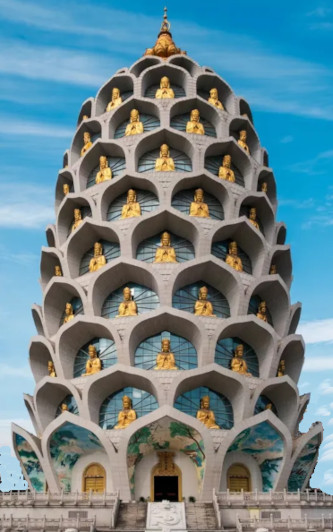The Maitreya Sacred Altar

The Maitreya Sacred Altar, is a renowned Buddhist site on the picturesque Xuedou Mountain, near Ningbo City, Zhejiang Province. This sacred altar is like a city in the sky, a temple in the clouds, resplendent in gold and radiating grandeur:

The Maitreya Sacred Altar and geodesic dome were designed by the Tsinghua University Architectural Design and Research Institute. Its design concept blends traditional culture with modern technology, exceptional artistry, and functionality.
The structure shines with golden brilliance on the outside and revealing a unique interior. The combination of classical and modern styles offers a journey through time+space, evoking the profound and vast essence of Buddhist culture.
This entire project covers an abandoned vast quarry. It is designed in the shape of a flower bud, with a difference in height of 35 mtrs. It spans over 300 acres, with a total floor space of 51K sqm, cost US$ 140 Mio. Opened in 10/2024:

The Maitreya Altar is the core of this project, which is divided into 4 main parts:
- the Great Mercy Hall in the front,
- the Longhua Dharma Hall,
- the vertical structure of Sumeru Mountain, and
- the Adytum of Tushita Heaven at the top.
Three halls representing other Dvipas are designed around the Altar, namely Purvavideha in the east, Aparagodaniya in the west of the Altar, and Uttarakuru in the north, while the Altar represents the Jambudvipa itself.
It will be the main venue of the Maitreya Cultural Festival, religious lectures, conferences, exhibitions, and cultural exchange activities with large audiences.
A vertical structural element is inserted under the center of the shelled glass roof for vertical ventilation, equipment, and structural reasons. It connects the deep underground with the roof space. Above this glass roof are the splendid group of buildings in traditional Chinese style.
The surrounding rock wall of this vast quarry was simply reinforced and left alone to maintain the original traces, thus forming a contrast between the modern architectural structure and the authentic natural environment, highlighting the Buddhist concept of conserving and nourishing nature after the indigenization of Buddhism.

Original quarry rock wall


Guanyin 'Pineapple' Pagoda,
Changzhou, China
The outer cabinet of this 91.9 m. tower is made up of 108 lotus petal-shaped Buddha niches, with a golden Buddha Arhat inside. A 39-m-high 3-faced 10-direction Guanyin is enshrined in the center of this cabinet.

